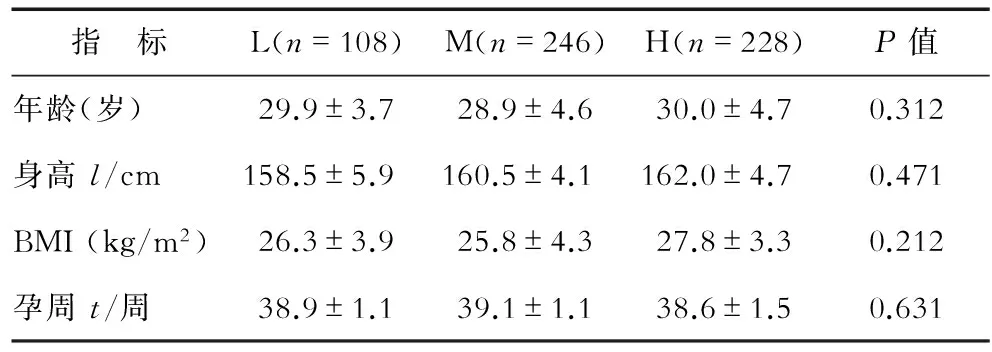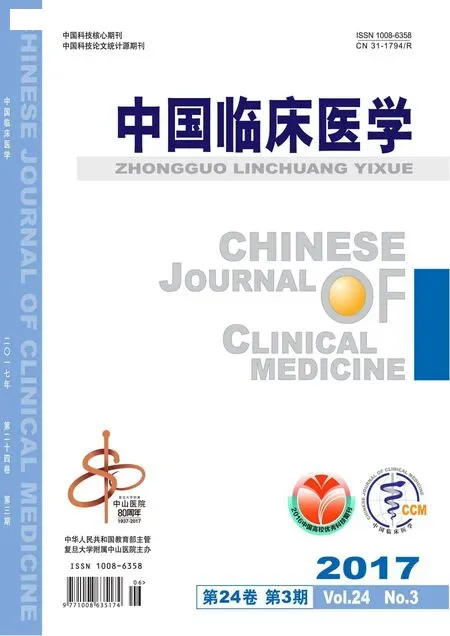椎管内阻滞分娩镇痛时产妇宫缩疼痛程度对剖宫产率的影响
孙星峰, 田复波, 黄绍强, 耿桂启
复旦大学附属妇产科医院麻醉科,上海 200090
·短篇论著·
椎管内阻滞分娩镇痛时产妇宫缩疼痛程度对剖宫产率的影响
孙星峰, 田复波, 黄绍强*, 耿桂启
复旦大学附属妇产科医院麻醉科,上海 200090
目的: 探讨椎管内阻滞用于分娩镇痛时产妇宫缩疼痛程度对剖宫产率的影响。方法: 选择单胎、头位、宫口<4 cm,无产科并发症产妇590例,根据数字评分量表(NRS)评分,将其分为3组:L(1~4分)组、M(5~7分)和H(8~10分)组。产妇均于腰2~3或腰3~4间隙进行硬膜外穿刺。行硬膜外镇痛者硬膜外腔给予实验剂量1.0%碳酸利多卡因5 mL,待阻滞平面出现后给予负荷剂量0.1%罗哌卡因复合5 μg舒芬太尼混合液10 mL,观察30 min无不良反应后连接患者自控硬膜外镇痛泵(PCEA)。行CSEA镇痛者硬膜外穿刺成功后蛛网膜下隙注入0.1%罗哌卡因复合3 μg舒芬太尼混合液3 mL,90 min后连接PCEA。观察并记录行镇痛前产妇的NRS评分;第一产程时间、第二产程时间和分娩方式。结果: 3组间镇痛后30 min NRS评分、宫口大小、第一产程时间、第二产程时间组间比较差异无统计学意义;3组间产钳助产率和剖宫产率比较差异无统计学意义。结论: 椎管内阻滞分娩镇痛时产妇的宫缩疼痛程度对剖宫产率无明显影响。
硬膜外,脊髓;分娩镇痛;剖宫产率;剖宫产术
分娩过程中的疼痛程度被认为与产程的延长和剖宫产率的增加有关。分娩疼痛程度因个体的身体状况、精神状态和产程中宫颈的扩张程度不同而不同。目前对于分娩镇痛前产妇的宫缩疼痛程度对分娩方式的影响存在不同的观点,有人认为,硬膜外阻滞(epidural analgesia, EA)分娩镇痛前产妇的疼痛程度可影响产科结局[1-4];相反的,有人认为硬膜外阻滞实施分娩镇痛前产妇的疼痛程度与分娩方式无关[5-7]。腰麻-硬膜外联合阻滞(combined spinal and epidural analgesia, CSEA)用于分娩镇痛虽在临床推广已久,但在其实施前产妇的宫缩疼痛程度对产科结局的影响尚不清楚。因此,本研究拟评价两种椎管内阻滞镇痛方法实施前产妇的宫缩疼痛程度对分娩方式的影响。
1 资料与方法
1.1 病例选择及分组 本研究经复旦大学附属妇产科医院伦理委员会批准,产妇均知情同意并签署知情同意书。选择本院2015年7月至12月收治的产妇590例。入选标准:年龄21~40岁、体质指数(body mass index, BMI) 24~30 kg/m2,ASA分级Ⅰ~Ⅱ级,单胎、头位、孕37~41周、宫口<4 cm,无产科合并症及并发症,经产科医师评价能阴道分娩者。根据产妇要求行分娩镇痛时的数字评分量表(NRS,10 cm疼痛评分尺:0表示无痛;10表示最难以忍受的疼痛)评分,将其分为3组:L(NRS 1~4分)组、M(NRS 5~7分)和H(NRS 8~10分)组。
1.2 麻醉方法 产妇自愿要求行分娩镇痛,胎心监护显示无异常,宫口<4 cm,完善监测,开放静脉通路。产妇均于腰2~3或腰3~4间隙进行硬膜外穿刺。行EA镇痛者硬膜外穿刺成功后头向置管4 cm,给予实验剂量1.0%碳酸利多卡因5 mL,待阻滞平面出现后给予负荷剂量0.1%罗哌卡因复合5 μg舒芬太尼混合液10 mL,观察30 min无不良反应后连接患者自控硬膜外镇痛泵(PCEA)。行CSEA镇痛者硬膜外穿刺成功后运用“针内针”法行腰麻穿刺,蛛网膜下隙注入0.1%罗哌卡因复合3 μg舒芬太尼混合液3 mL,随后硬膜外腔头向置管4 cm,90 min后连接PCEA。PCEA方案:镇痛药配方为0.1%罗哌卡因与0.5 μg/mL舒芬太尼混合液,背景剂量6 mL/h,6 mL,锁定时间20 min。
1.3 观察指标 观察并记录行镇痛前产妇的NRS评分、镇痛后30 min NRS评分,宫口大小,所有产妇的镇痛前和镇痛后30 min的平均动脉压(MAP)、心率(HR)和胎心率(FHR),第一产程时间(从规律宫缩镇痛开始至宫口10 cm),第二产程时间(从宫口10 cm至胎儿娩出),分娩方式(自然分娩、器械助产和剖宫产),催产素使用情况,发热(≥38℃)情况;新生儿体质量和1 min、5 min的Apgar评分。

2 结 果
2.1 一般资料 结果(表1)表明:M组6例、H组2例因社会因素行剖宫产手术,其数据未纳入统计学分析。各组产妇一般情况比较差异无统计学意义。

表1 各组产妇一般情况比较
2.2 各组产妇血流动力学结果和胎心率结果 结果(表2)表明:各组产妇镇痛前和镇痛后30 min MAP、HR和FHR组间比较差异无统计学意义。

表2 各组产妇镇痛前和镇痛后30 min MAP、HR及FHR的比较
1 mmHg=0.133 kPa
2.3 不同组别产妇产科过程和分娩方式的对比 结果(表3)表明:3组间镇痛后30 min NRS评分、宫口大小、第一产程时间、第二产程时间、组间比较差异无统计学意义。3组间产钳助产率和剖宫产率比较差异无统计学意义。多变量回归分析显示:催产素使用率、发热发生率和镇痛方法对剖宫产率的影响3组间比较差异无统计学意义。

表3 各组产妇分娩特征和分娩方式的比较
2.4 3组间新生儿情况的比较 结果(表4)表明:各组间新生儿体质量、1 min和 5 min Apgar评分组间比较差异无统计学意义。

表4 新生儿预后情况的比较
3 讨 论
既往研究[3-4]表明:行EA分娩镇痛前的疼痛程度与剖宫产率有关,认为疼痛程度高的产妇难产率增加,引起剖宫产率增高。而本研究结果显示,行EA镇痛者3组间剖宫产率比较差异无统计学意义,疼痛程度高者并未显示难产率高,提示行EA分娩镇痛前产妇的疼痛程度对分娩方式没有影响,与Beilin等[5]报道的EA镇痛前产妇的疼痛程度对分娩方式影响的观察结果相似。
CSEA分娩镇痛被认为是目前镇痛效果最确切的分娩镇痛方法,相对于EA分娩镇痛,其起效迅速,镇痛效果确切,但同时使得血浆中儿茶酚胺和宫缩抑制剂水平迅速降低,导致子宫收缩增强,子宫血管阻力增加,胎儿氧供减少,引起胎心率异常发生率增加[8-10],可能导致剖宫产率增加。但本研究结果显示,行CSEA镇痛的产妇中H组剖宫产率并不比L组和M组高,提示行CSEA分娩镇痛前产妇的疼痛程度对分娩方式没有影响。同时,本研究结果显示3组剖宫产率均低于15%,而上述研究[4-5]各组剖宫产率均高于20%,提示CSEA分娩镇痛相比于EA分娩镇痛并不增加剖宫产率。另有研究[7,11]显示,相对于EA分娩镇痛,CSEA分娩镇痛可缩短产程。
本研究结果表明:产妇入选时一般情况和宫口大小各组间比较差异无统计学意义,说明产妇入选条件一致,分组标准只按疼痛评分高低划分。第一产程时间、第二产程时间和催产素使用率各组间比较差异无统计学意义。各组间新生儿比较差异无统计学意义,说明由新生儿因素引起的疼痛程度对各组的影响相同。因此,本研究结果基本消除了分娩过程中产科因素和产科医生因素对分娩方式的影响。
本研究参照文献[4-5]依据疼痛程度将入组产妇分为3组进行研究和分析;选择宫口<4 cm为纳入标准。根据预试验结果,选择本研究药物的剂量。本研究仍有一定的局限性:仅选择了日间行椎管内分娩镇痛的产妇,由于生物节律性的影响,夜间行分娩镇痛的产妇是否是相同结果,需要进一步研究。本研究样本的均一性不高,有待进一步完善。
综上所述,本研究结果提示椎管内阻滞用于分娩镇痛时产妇的宫缩疼痛程度对剖宫产率无明显影响。
[1] PANNI M K, SEGAL S. Local anesthetic requirements are greater in dystocia than in normal labor [J]. Anesthesiology,2003,98(4): 957-963.
[2] WUITCHIK M, BAKAL D, LIPSHITZ J. The clinical significance of pain and cognitive activity in latent labor [J].Obstet Gynecol,1989,73(1): 35-42.
[3] HESS P E, PRATT S D, SONI A K, et al. An association between severe labor pain and cesarean delivery [J].Anesth Analg,2000,90(4): 881-886.
[4] WOO J H, KIM J H, LEE G Y,et al. The degree of labor pain at the time of epidural analgesia in nulliparous women influences the obstetric outcome [J].Korean J Anesthesiol,2015, 68(3):249-253.
[5] BEILIN Y, MUNGALL D, HOSSAIN S, et al. Labor pain at the time of epidural analgesia and mode of delivery in nulliparous women presenting for an induction of labor[J].Obstet Gynecol,2009,114(4): 764-769.
[6] CHESTNUT D H, MCGRATH J M, VINCENT R D JR, et al. Does early administration of epidural analgesia affect obstetric outcome in nulliparous women who are in spontaneous labor?[J].Anesthesiology,1994,80(6):1201-1208.
[7] WONG C A, SCAVONE B M, PEACEMAN A M, et al. The risk of cesarean delivery with neuraxial analgesia given early versus late in labor [J].N Engl J Med, 2005,352(7):655-665.
[8] HATTLER J, KLIMEK M, ROSSAINT R,et al. The effect of combined spinal-epidural versus epidural analgesia in laboring women on nonreassuring fetal heart rate tracings: systematic review and meta-analysis[J].Anesth Analg, 2016,123(4):955-964.
[9] CLARKE V T, SMILEY R M, FINSTER M. Uterine hyperactivity after intrathecal injection of fentanyl for analgesia during labor: a cause of fetal bradycardia?[J].Anesthesiology,1994, 81(4):1083.
[10] SEGAL S, CSAVOY A N, DATTA S. The tocolytic effect of catecholamines in the gravid rat uterus[J].Anesth Analg,1998,87(4):864-869.
[11] TSEN L C, THUE B, DATTA S, et al. Is combined spinal-epidural analgesia associated with more rapid cervical dilation in nulliparous patients when compared with conventional epidural analgesia?[J].Anesthesiology,1999,91(4):920-925.
[本文编辑] 廖晓瑜, 贾泽军
Effect of the degree of labor pain at the time of intraspinal labor analgesia on the incidence of cesarean delivery
SUN Xing-feng, TIAN Fu-bo, HUANG Shao-qiang*, GENG Gui-qi
Department of Anesthesiology, the Obstetrics and Gynecology Hospital, Fudan University, Shanghai 200090, China
Objective: To assess the degree of labor pain at the time of intraspinal labor analgesia in women influencing the incidence of cesarean delivery. Methods: Five hundred and ninety patients were enrolled in the study and divided into 3 groups in the light of numeric rating scale (NRS). The woman was with singleton pregnancies, with cervical dilatation of less than 4 cm and vertex fetal presentations. Namely, L group:1-4;M group:5-7;H group:8-10, respectively. The EA procedure was performed at the lumbar spine between 2-3 or 3-4. We inserted a catheter into the epidural space started with 1.0% carbonated Lidocaine to make the volume 5 mL. After the block plane arising, injected a mixture of 0.1% Ropivacaine co-administered with 5 μg of Sufentanil to make the total volume 10 mL in all cases, and connected the patient controlled epidueal analgesia (PCEA) thirty minutes later. The CSEA procedure was started with an intrathecal standard mixture of 0.1% Ropivacaine co-administered with 3 μg of Sufentanil to make the total volume 3 mL in all cases, then connected the PCEA ninety minutes later. To observe and record the NRS score when analgesia was performed. The time of the first stage of labor, the time of the second stage of labor and the way of delivery were recorded in our study respectively. Results: There was no statistically significant differences among the three pain groups in the NRS score after 30 min, dilatation, duration of first stage of labor and duration of second stage of labor, respectively. There was no statistically significant differences among the three pain groups in the incidence of instrumental delivery and cesarean delivery. Conclusions: There is no effect of the degree of labor pain at the time of intraspinal labor analgesia in women on the incidence of cesarean delivery.
epidural, spinal; labor analgesia;incidence of cesarean delivery; cesarean section
2017-01-10 [接受日期] 2017-05-31
孙星峰,硕士,主治医师. E-mail: xfsunok@126.com
*通信作者(Corresponding author). Tel: 021-33189900, E-mail: timrobbins71@163.com
10.12025/j.issn.1008-6358.2017.20170032
R 614.4+1
A

